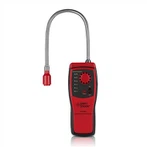Maintenance and sensor life for gas detectors
The maintenance of the gas detector and the life of the sensor
Gas detector is an instrumentation tool for gas leakage concentration detection, including: portable gas detector, handheld gas detector, fixed gas detector, online gas detector, etc. Gas sensors are mainly used to detect the types of gases existing in the environment. Gas sensors are sensors used to detect the composition and content of gases.
It is generally believed that the definition of gas sensors is based on the classification of detection targets, that is to say, any sensor used to detect gas composition and concentration is called a gas sensor, regardless of whether it uses physical methods or chemical methods. For example, sensors that detect gas flow are not considered gas sensors, but thermal conductivity gas analyzers are important gas sensors, although they sometimes use roughly the same detection principle.
Classification
Semiconductor
It is manufactured by using some metal oxide semiconductor materials, and at a certain temperature, the electrical conductivity changes with the change of the ambient gas composition. For example, the alcohol sensor is prepared by using the principle that the resistance of tin dioxide will decrease sharply when it encounters alcohol gas at high temperature.
advantage
Semiconductor gas sensors can be effectively used for the detection of many gases such as methane, ethane, propane, butane, alcohol, formaldehyde, carbon monoxide, carbon dioxide, ethylene, acetylene, vinyl chloride, styrene, acrylic acid, etc. In particular, the sensor has low cost and is suitable for the needs of civilian gas detection. The following semiconductor gas sensors are successful: methane (natural gas, biogas), alcohol, carbon monoxide (city gas), hydrogen sulfide, ammonia (including amines, hydrazines). High-quality sensors can meet the needs of industrial detection.
shortcoming
The stability is poor, and it is greatly affected by the environment; especially, the selectivity of each sensor is not unique, and the output parameters cannot be determined. Therefore, it is not suitable for use in places where accurate measurement is required.
Combustion
This sensor prepares a high temperature resistant catalyst layer on the surface of the platinum resistor. At a certain temperature, the combustible gas is catalytically burned on its surface. The combustion is the temperature rise of the platinum resistor, and the resistance changes. The change value is the concentration of the combustible gas. function.
thermal conductivity pool
Each gas has its own specific thermal conductivity. When the thermal conductivity of two or more gases is quite different, the thermal conductivity element can be used to distinguish the content of one of the components. This sensor has been used sensorily for the detection of hydrogen, the detection of carbon dioxide, and the detection of high-concentration methane.
maintainance
1. Check the gas flow rate, usually 30/h, if the flow rate is too large or too small, it will have a great impact on the analyzer results
the
2. Replace the filter paper: stop the air pump and drain the filter tank
the
3. Check whether there is any air leakage in the air system. Whether the diaphragm of the weeping pump is damaged, whether the sealing ring of the sampling probe is broken, whether the four-way valve and condensate are damaged, etc.
4. Clean the sampling probe and dredge the sampling hole pipeline
5. Check whether the condenser works normally, usually the temperature is adjusted within 3 degrees Celsius
6. Check the measuring chamber to see if it is dirty, and clean it in time.






